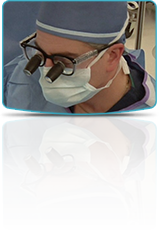Men’s Hair Restoration
As they age, most men experience some degree of hair loss or thinning. A strong family history of balding in male ancestors, a history of scalp surgery, severe burns, trauma or medically-induced changes in hormonal balance are all risk factors which may amplify or accelerate standard age-related hair loss. The typical distribution of hair loss seen in most males includes variable involvement of the hair bearing scalp in the vertex (upper, back midline), frontal forelock (central front hairline), parasaggital region (extending out from and on either side of the central top midline), and temporal area (front portion of hairline of the temples). The posterior temporal and occipital regions (back portion of the temples and lower back hairline) are invariably spared in males. This distribution of hair loss is commonly referred to as ‘male pattern balding’. For some individuals, hair loss is viewed as an acceptable part of the normal aging process and they adapt appropriately to their maturing hairline. However, others may be dissatisfied with their changing appearance and unwilling to passively accept progressive hair loss. For these patients, hair restoration may provide the perfect solution.
Over the recent 10-20 years, significant progress has been made in the recognition and understanding of hair anatomy and physiology. This has resulted in the performance of increasingly sophisticated techniques for natural hair replacement, leading up to the development of ‘follicular unit’ hair transplantation as the modern ‘gold standard’ procedure for hair restoration. Performed under local anesthesia with oral sedation as an outpatient procedure in a State Licensed, Nationally Accredited Ambulatory Surgery Center (see ‘about Keystone Surgery Center’), follicular unit hair restoration involves removal of a thin strip of hair-bearing scalp from the back of one’s head (occipital region). This hair ‘donor site’ is then immediately closed, forming a fine line scar, concealed by the surrounding hair and completely imperceptible. The hair within this harvested strip of tissue is then carefully, microsurgically separated into its component hair follicles by a skilled medical team. Under magnification, these follicular units are then inserted into small puncture sites within the area of hair loss. Throughout this procedure, patients remain awake and comfortable, generally watching their favorite television programs. The results of follicular unit hair transplantation can be further enhanced by the use of oral (eg. Finasteride) and/or topical (eg. Minoxodil) agents to minimize genetically programmed ongoing hair loss and support and stabilize grafted hair follicles.
When considering a program of hair restoration, be sure to select a qualified, experienced plastic surgeon, certified by the American Board of Plastic Surgery (ABPS). As a board certified plastic surgeon with over 15 years of clinical practice experience and member of the American Society of Plastic Surgeons (ASPS) and American Society of Aesthetic Plastic Surgery (The Mark of Distinction in Cosmetic Plastic Surgery® ASAPS), Dr. Robert Kimmel welcomes the opportunity to help you achieve your goals by enhancing your appearance and enjoy a happier, more confident lifestyle.
We are proud to serve patients from Scranton, Allentown, and Harrisburg.
What Are the Benefits of Male Hair Restoration?
The primary benefit of hair restoration via hair transplant surgery is that you can reclaim your sense of self! Thinning hair and balding can severely affect your satisfaction with your appearance as well as your overall confidence. Restoring a natural-looking growth pattern, hairline, and optimal thickness can make you look and feel younger. The process is minimally-invasive, requires little downtime, and achieves proven results that are easy to manage over time.
Who is a Candidate for Male Hair Restoration?
If you are concerned about the appearance of your hair and want to improve your hair growth, you may be a good candidate for hair restoration treatment. We consult with men and women who want help treating thinning hair on the scalp, a bald spot, or correcting a receding hairline. Hair restoration treatment can be sought at any age. However, it is vital that you are in good healthy and have a strong immune system. Having a chronic health condition like diabetes may adversely affect your treatment outcome, as can taking certain medications, such as blood thinners. You can expect Dr. Kimmel to conduct a comprehensive medical history review and health exam. This helps him ensure that you can safely undergo treatment and that your investment into future hair growth can offer satisfying rewards. One of the aspects of your consultation is to evaluate the type of hair loss you have as well as the quality of hair in the donor site. If you would like to regain a fuller, thicker head of hair, contact us. Dr. Kimmel will use the information obtained during your consultation and examination to develop a treatment plan around your unique situation.
How Do Male Hair Restoration Treatments Work?
Our hair restoration method works by literally replacing your inactive hair follicles with new ones that are obtained from the back area of your head. By inserting the individual grafts that are taken from a small strip of your scalp, the doctor recreates, one hair follicle at a time, a new, natural-looking hair growth pattern in the area of thinning or baldness.
Is Male Hair Restoration Painful?
No. Your hair replacement treatment is performed in our surgical suite using a local anesthetic and sedation. You won’t be asleep as you would under general anesthesia, but you will be relaxed and pain-free. The local anesthetic and sedative medication work together to desensitize the treatment area and also subtly diminish your nervous system reactivity for a short time. After your treatment, your scalp will feel sore and tender. Your care instructions will contain specific information regarding how to manage these side effects.
How Long After a Male Hair Restoration Treatment Will I See Results?
You will see a difference in the thickness of your hair immediately after your treatment. However, the hair that is present in the transplanted follicles will soon shed. This is a normal part of the shock of the transplant process. Within a few months, you can expect to see new hair growth occurring. Approximately 60 percent of new hair growth can be seen six to nine months after the hair transplant procedure.
Are My Male Hair Restoration Results Permanent?
Hair transplant procedures are intended for long-term results. The hair follicles that are transplanted are expected to remain active for the foreseeable future. However, there is no way to guarantee that age-related biological changes will not affect hair growth to some degree. Dr. Kimmel may recommend the continued use of oral and/or topical medications after the hair restoration treatment has achieved its purpose.









 THE OFFICE
THE OFFICE